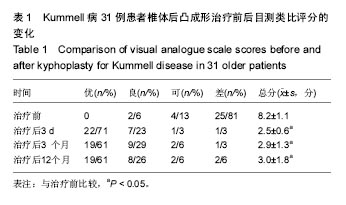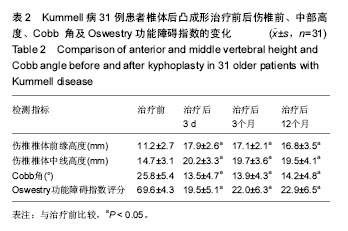| [1]Li H,LiangCZ,Chen QX.Kummells disease,an uncommon and complicated spinal disorder:a riview.J Int Med Res. 2012; 40(2):406-414.[2]杨惠林,王根林,姜为民.分次灌注骨水泥技术治疗Kummell病[J].脊柱外科杂志,2012,10(1):22-24.[3]陈锋,方文来,倪文飞.Kummell病的治疗进展[J].中国骨与关节损伤杂志,2013,28(1):95-96.[4]贾崇哲,唐海,陈浩,等.聚甲基丙烯酸甲酯骨水泥的基础研究进展[J].临床和实验医学杂志,2017,16(5): 519-521.[5]Ren HL,Jiang JM,Chen JT,et al.Risk factors of new symptomatic vertebral compression fracture in osteoporotic patients undergone percutaneous vertebroplasty.Eur spine J.2015;24(4):750-758.[6]Ledlie JT,Renfro MB.Kyphoplasty treatment of vertebral fractures: 2-year outcomes show sustained benefits.Spine. 2006;31(1):57-64.[7]印平,马远征,马迅,等.骨质疏松性椎体压缩性骨折的治疗指南[J].中国骨质疏松杂志,2015,21(6):643-648.[8]Matzaroglou C,Georgiou CS,Panagopoulos A,et al.Kummells disease:Clarifying the Mechanisms and Patients Inclusion Criteria.Open Orthop J.2014;15(8):288-297. [9]胥少汀,葛宝丰,徐印坎.实用骨科学[M].4版.北京:人民军医出版社,2012:1813.[10]Kummell H.Die rarefizierende ostitis der Wirbelko.Deutsche Med.1895;21(1):180-181.[11]Ma R,Chow R,Shen FH.Kummell’s disease:delayed post-traumatic osteonecrosis of the vertebral body .Eur Spine J.2010;19(7):1065-1070. [12]谢胜荣,卢小刚,伍成东,等.Kummell病的发病机制研究进展[J].中华临床医师杂志(电子版),2014,8(20): 3675-3678.[13]Matzaroglou C,Georgiou CS,Assimakopoulos K,et al. Kummell’s disease: pathophysiology, diagnosis,treatment and the role of nuclear medicine.Rationale according to our experience.Hell J Nucl Med.2011;14(3):291-299.[14]Kong LD,Wang P,Wang LF,et al.Comparison of vertebroplasty and kyphoplasty in the treatment of osteoporotic vertebral compression fractures with intravertebral cleft.Eur J Orthop Surg Traumatol.2014;24 Suppl 1:S201-208.[15]Ranjan M,Mahadevan A,Prasal C,et al.Kummell’s disease uncommon or underreported disease: A clinicopathological account of a case and review of literature.J Neurosci Rural Pract.2013;4(4):439-442.[16]李良辰,何登伟,黄文君,等.Kummell病椎体裂隙征发生机制的研究进展[J].中华骨质疏松和骨矿盐疾病杂志,2015,8(4):363-366.[17]Wu AM,Chi YL,Ni WF,et al.Vertebral compression fracture with intervertebral vacuum cleft sign: pathogenesis, image,and surgical intervention.Asian Spine J.2013;7:148-155.[18]Feng SW,Chang MC,Wu HT,et al.Are intravertebral vacuum phenomena benignlesions?Eur Spine J.2011;20(8):1341-1348. [19]Zhang GQ,Gao YZ,Zheng J,et al.Posterior decompression and short segmental pedicle screw fixation combined with vertebroplaty for Kummell’s disease with neurological deficits. Exp Ther Med.2013;5(2):517-522.[20]Wang Q,Wang C,Fan S,et al.Pathomechanism of intravertebral clefts in osteoporotic compression fracture of the spine: basivertebral foramen collapse might cause intravertebral avascular necrosis.Spine J.2014;14(6):1090-1091.[21]伍成东,谢胜荣,卢小刚,等.Kummell病的影像学研究进展[J].中华临床医师杂志(电子版),2014,8(24): 4489-4491.[22]Kim YC,Kim YH,Ha KY,et al.Pathomechanism of intravertebral clefts in osteoporotic compression fracture of the spine.Spine J.2014;14(4):659-666.[23]Nickell LT,Schucany WG,Opatowsky MJ.Kummell’s disease.Proc(Bayl Univ Med Cent).2013; 26(3):300-301.[24]刘冬斌.经皮椎体成形术治疗Kummell病的临床效果分析[J].微创医学,2015,10(3):316-319.[25]蔡俊,冯新民,王静成,等.椎体成形术治疗不愈合的胸腰椎陈旧性骨折疗效分析[J].创伤外科杂志,2015,17(5):426-429.[26]周毅,海涌,苏庆军,等.椎体后凸成形术治疗骨质疏松椎体压缩性骨折疗效分析[J].中国骨质疏松杂志,2012,18(5):429-433.[27]姚女兆,夏曦,唐绍峰.序贯椎体成形术治疗Kummell病的疗效观察[J].中国修复重建外科杂志,2015,29(10): 1265-1268.[28]刘继军,刘志勇,郝阳泉,等.椎体后凸成形术治疗Kummell病的临床疗效分析[J].实用骨科杂志,2015, 21(7):585-588. |
.jpg)



.jpg)